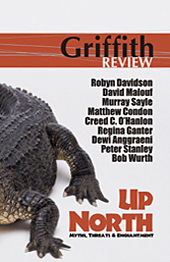Featured in

- Published 20050906
- ISBN: 9780733316715
- Extent: 232 pp
- Paperback (234 x 153mm)

Already a subscriber? Sign in here
If you are an educator or student wishing to access content for study purposes please contact us at griffithreview@griffith.edu.au
Share article
About the author

Regina Ganter
Regina Ganter has just published Mixed Relations (University of Western Australia Press), a study of Asian/Aboriginal contacts in northern Australia.For her earlier work, The...
More from this edition

We’re all eccentrics here
ReportageHALFWAY BETWEEN DARWIN and Tennant Creek – around 500 clicks each way – there's a wide spot in the road called Larrimah. Some travellers...

Howard’s way: northerly neighbours and western friends
EssayIT IS VERY hard to find good, objective writing about the philosophies, motivations and political skills of this country's second-longest-serving prime minister. It seems...

Curtin’s hand of friendship
ReportageI was engaged in conversation with the Governor-General and his wife after the dinner when an elderly lady, apparently a friend of the Governor-General's...